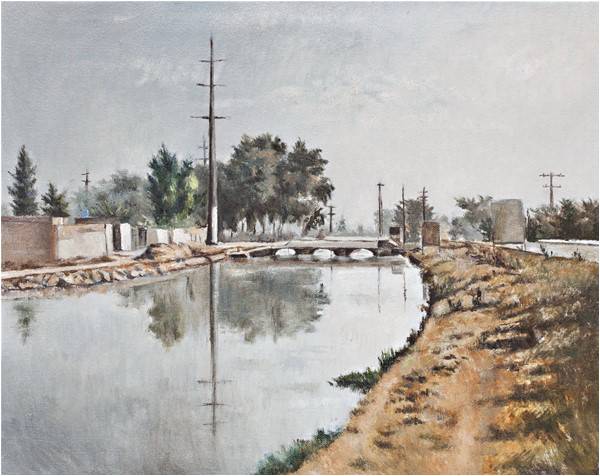
Nazir Ahmad (born in 1952) is one of Pakistan’s most eminent landscape painters. He is one of the skilled landscape painters currently pushing the boundaries and pursuing this form of painting along with others of the generation that was taught by Khalid Iqbal (1929 - 2014) and ardently continues to follow his school of painting. Nazir Ahmad was awarded with the Pakistani state award, the Tamgha-i-Imtiaz, in 2012 for his contributions.
It goes without saying, of course, that any creative profession is a labour of love. It calls for sacrifice and commitment. However, the labour in some such professions is much more than that involved in the others. Landscape painting is one of those artistic expressions requiring a lot of hard work besides creativity. It is not just a romantic act - the impression one might get when they come across a beautiful landscape painting in the indoors that opens to them the vistas of the outside world. It is a result of braving harsh seasons and incrementally building an understanding of the outdoor environment - which is always in a flux unlike a controlled studio environment.
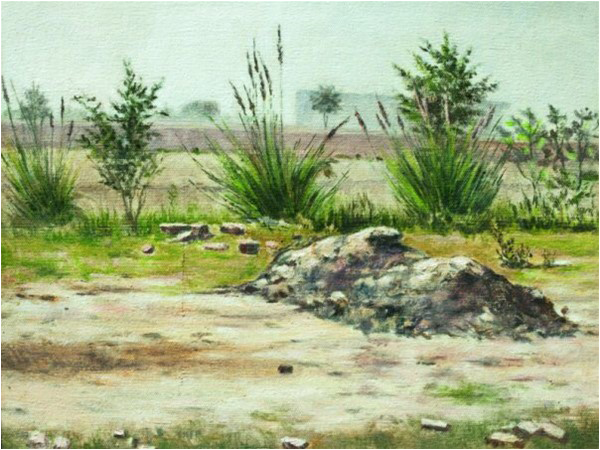
Nazir Ahmad’s landscapes - done in pen and ink, water colour and oil paint – speak volumes about this labour of love. He has indulged in this pursuit for more than four decades and his work is the result of in-depth observation, understanding and direct communication with his surroundings.
Ahmad narrates how once he painted an Amaltas tree again and again over the course of a year. This ecstatic experience enabled him to observe changing colours, atmosphere and shadows of the tree and its surroundings. As an artist he captured the changes with hours of the day and seasons of the year. Indeed, it is a spiritual journey for him in praising the magnificence of the Creator. The exercise of painting a particular object over the course of time is very much a mainstay of the tradition of landscape painting. The great Monet painted his Haystack series over a period of time to study the effects of light.
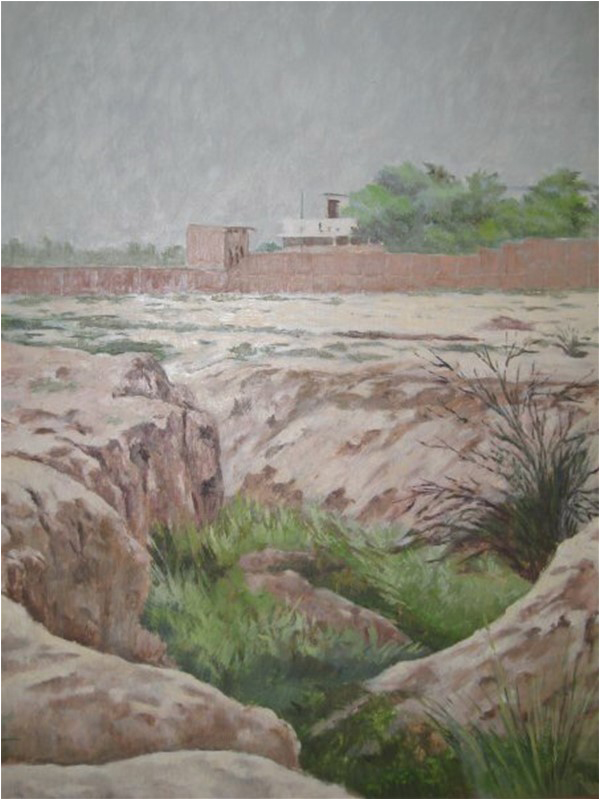
Nazir Ahmad has extensively painted Lahore and the rural areas in the vicinity of that great city. He came from an agrarian background and landed at the National College of Arts, Lahore, in the 1970s. The agrarian context ingrained in him a love of the outdoors and a zest to seize them. His proximity to nature and his motherland is evident in his paintings of steppe-like barren land with a trees or wild shrubs strewn around. Such a landscape is difficult to paint because, to begin with: how would you put the random hard and brittle tones of Punjab’s soil on the canvas and then also make it an interesting composition for the audience?
Some of his favourite areas include the river Ravi, which despite shrinking still has some fine painting spots. Lahore’s Canal is yet another spot with beautiful drooping trees. Both spots are linked to his desire to paint water as its colour alters with every twist and turn. Canals or water channels of Punjab make for interesting painting composition and contain enough twists and turns to challenge a landscape painter with rough slanting surfaces, flowing water, angular composition and reflections etc. Similarly, the colours of the burning yellow Amaltas tree, the red Flame of the Forest tree, the shades of the Sumbal tree and the form of the Keekar tree in different backgrounds have also attracted Ahmad’s eye.
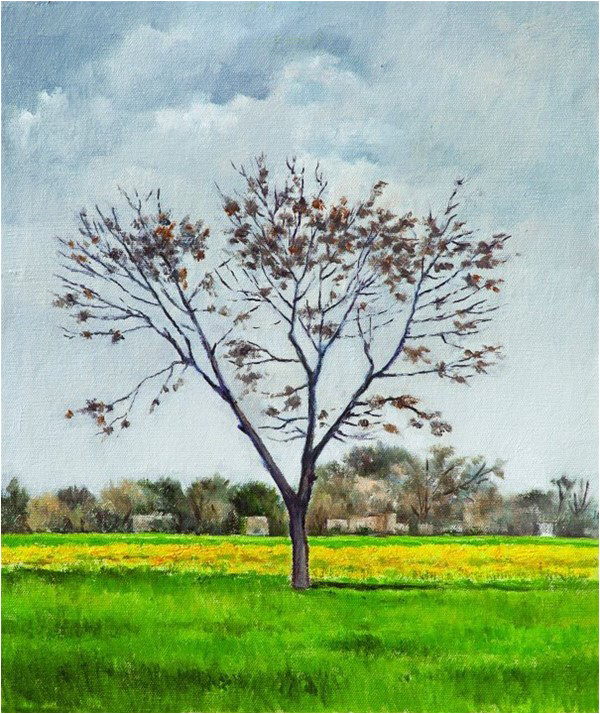
When Nazir Ahmad moves to the rural areas, the vast expanse of village landscape with yellowish hues of sarson (mustard greens) becomes his subject. He observed the change in contrast of colours and atmosphere in villages. In his latest work, his compositions - be they trees, crops or structures - appear to have been painted in a single wash: a quality of classic Khalid Iqbal. Ahmad has great deference for his teachers Khalid Iqbal, Saeed Akhtar and Colin David who, he thinks, despite exposure to Western art education, produced a body of work rooted in the country’s history and heritage. He still recalls how, in his college years, Khalid Iqbal told him that as a painter he had “feelings” for landscape - a must as far as Iqbal was concerned, for a painter to successfully paint a landscape. Probably that also inspired him to do “on spot” painting, much like Khalid Iqbal used to do, so as to fully absorb the atmosphere being painted.
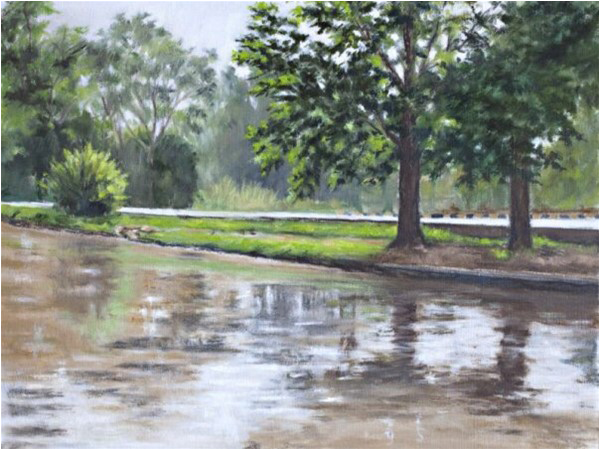
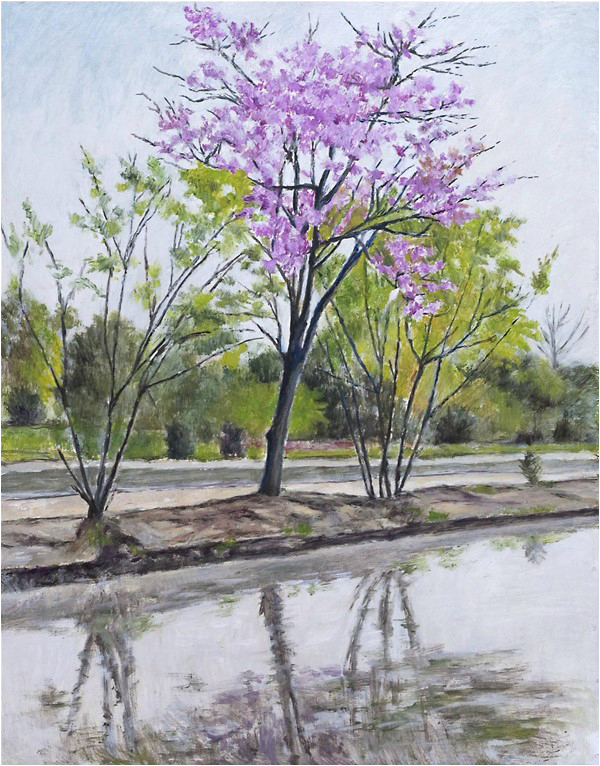
Some critics have expressed concerns that landscape painting has reached a plateau and that there is no experimentation. Ahmad differs with that view and argues that experimentation has been part of landscape painting since very long in Pakistan. Be it Colin David, Ustad Abdul Rehman Ijaz (father of famous photographer Mian Majeed) or Abdul Rehman Chugtai and others: all contributed to bringing a newer angle to landscape painting in Pakistan.
Pakistan’s master painter and Ahmad’s teacher and mentor Saeed Akhtar, commenting on Ahmad’s landscape details, observed that in particular, the water painted by him shows its colour, depth and pace of flow. And with such reviews of his work, Ahmad continues to successfully explore the rich landscape of his country.
The writer can be reached at smt2104@caa.columbia.edu
It goes without saying, of course, that any creative profession is a labour of love. It calls for sacrifice and commitment. However, the labour in some such professions is much more than that involved in the others. Landscape painting is one of those artistic expressions requiring a lot of hard work besides creativity. It is not just a romantic act - the impression one might get when they come across a beautiful landscape painting in the indoors that opens to them the vistas of the outside world. It is a result of braving harsh seasons and incrementally building an understanding of the outdoor environment - which is always in a flux unlike a controlled studio environment.

Nazir Ahmad’s landscapes - done in pen and ink, water colour and oil paint – speak volumes about this labour of love. He has indulged in this pursuit for more than four decades and his work is the result of in-depth observation, understanding and direct communication with his surroundings.
Ahmad narrates how once he painted an Amaltas tree again and again over the course of a year. This ecstatic experience enabled him to observe changing colours, atmosphere and shadows of the tree and its surroundings. As an artist he captured the changes with hours of the day and seasons of the year. Indeed, it is a spiritual journey for him in praising the magnificence of the Creator. The exercise of painting a particular object over the course of time is very much a mainstay of the tradition of landscape painting. The great Monet painted his Haystack series over a period of time to study the effects of light.

Ahmad narrates how once he painted an Amaltas tree again and again over the course of a year
Nazir Ahmad has extensively painted Lahore and the rural areas in the vicinity of that great city. He came from an agrarian background and landed at the National College of Arts, Lahore, in the 1970s. The agrarian context ingrained in him a love of the outdoors and a zest to seize them. His proximity to nature and his motherland is evident in his paintings of steppe-like barren land with a trees or wild shrubs strewn around. Such a landscape is difficult to paint because, to begin with: how would you put the random hard and brittle tones of Punjab’s soil on the canvas and then also make it an interesting composition for the audience?
Some of his favourite areas include the river Ravi, which despite shrinking still has some fine painting spots. Lahore’s Canal is yet another spot with beautiful drooping trees. Both spots are linked to his desire to paint water as its colour alters with every twist and turn. Canals or water channels of Punjab make for interesting painting composition and contain enough twists and turns to challenge a landscape painter with rough slanting surfaces, flowing water, angular composition and reflections etc. Similarly, the colours of the burning yellow Amaltas tree, the red Flame of the Forest tree, the shades of the Sumbal tree and the form of the Keekar tree in different backgrounds have also attracted Ahmad’s eye.

The colours of the burning yellow Amaltas tree, the red Flame of the Forest tree, the shades of the Sumbal tree and the form of the Keekar tree, all attracted Ahmad's eye
When Nazir Ahmad moves to the rural areas, the vast expanse of village landscape with yellowish hues of sarson (mustard greens) becomes his subject. He observed the change in contrast of colours and atmosphere in villages. In his latest work, his compositions - be they trees, crops or structures - appear to have been painted in a single wash: a quality of classic Khalid Iqbal. Ahmad has great deference for his teachers Khalid Iqbal, Saeed Akhtar and Colin David who, he thinks, despite exposure to Western art education, produced a body of work rooted in the country’s history and heritage. He still recalls how, in his college years, Khalid Iqbal told him that as a painter he had “feelings” for landscape - a must as far as Iqbal was concerned, for a painter to successfully paint a landscape. Probably that also inspired him to do “on spot” painting, much like Khalid Iqbal used to do, so as to fully absorb the atmosphere being painted.


Some critics have expressed concerns that landscape painting has reached a plateau and that there is no experimentation. Ahmad differs with that view and argues that experimentation has been part of landscape painting since very long in Pakistan. Be it Colin David, Ustad Abdul Rehman Ijaz (father of famous photographer Mian Majeed) or Abdul Rehman Chugtai and others: all contributed to bringing a newer angle to landscape painting in Pakistan.
Pakistan’s master painter and Ahmad’s teacher and mentor Saeed Akhtar, commenting on Ahmad’s landscape details, observed that in particular, the water painted by him shows its colour, depth and pace of flow. And with such reviews of his work, Ahmad continues to successfully explore the rich landscape of his country.
The writer can be reached at smt2104@caa.columbia.edu

